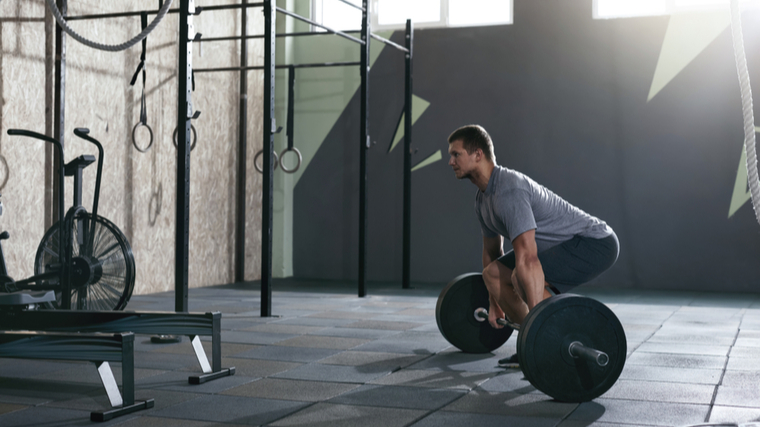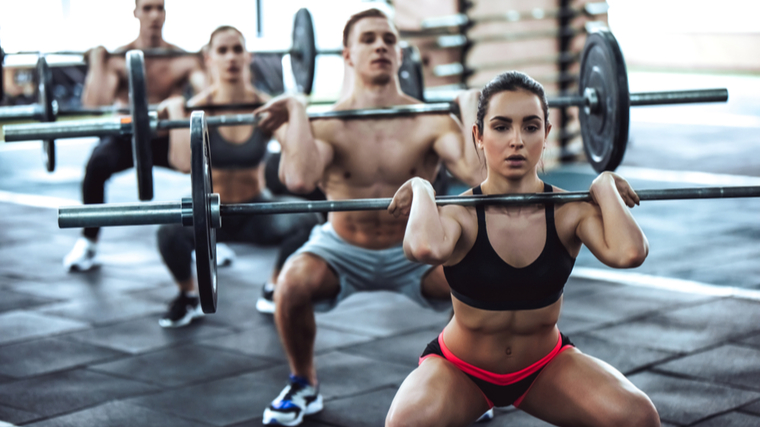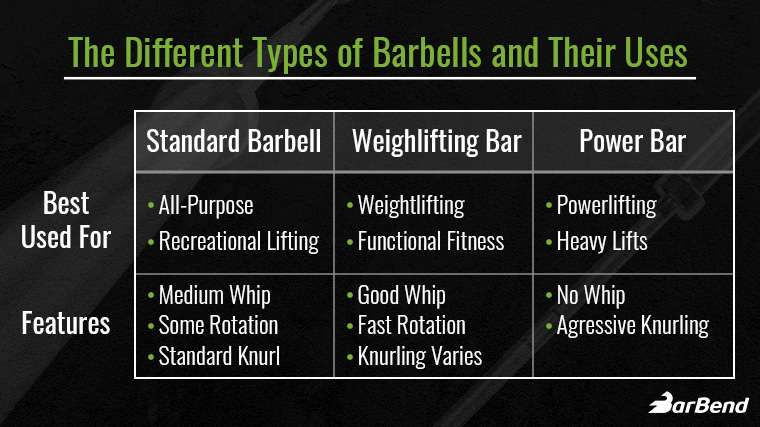To the untrained eye, a bag of golf clubs may look like little more than a collection of shiny sticks. For the professional golfer, that same bag contains the specific tools they need to get the job done out on the green. The same principle holds true for strength athletes and their relationship with the barbell.
The barbell is the universal training implement. Bodybuilders mold and morph their physiques with it, powerlifters and weightlifters put all their might into moving it off the floor or to arm’s length, and every high-level CrossFitter knows how perilous a workout consisting of thrusters for time can be.

However, much like how a golfer will seek a certain club for a certain shot, there’s more than one type of barbell out there — and far more ways to utilize them than you might think. Below is a list of nearly every type of bar, and what they’re good for.
Types of Barbells
- Standard Barbell
- Fixed Bar
- Trap Bar
- Cambered Bar
- Axle Bar
- Safety Bar
- Log Bar
- Swiss Bar
- Elephant Bar
- Duffalo Bar
- Tsunami Bar
Standard Barbell
The standard barbell that you’ll find in nearly every commercial gym on Earth is typically seven feet, two inches long and weighs either 20 kilograms (44 pounds) or 45 pounds exactly. They’re almost always made of coated steel and are engraved with knurling, a textured surface designed to help you maintain a tight grip.
Powerlifting Bar
Generally, the barbells used in powerlifting are rigid and not particularly bendy — though there are exceptions, such as the bars specifically designed for deadlifting. Powerlifting barbells also commonly have center knurling to secure the bar across your upper back for squats.
You’ll also find that the grip markers — smooth, finger-sized breaks in the knurling — are closer together. Grip markers serve as guidance for how wide you can hold the bar in the bench press, though the limitations vary according to which powerlifting federation you’re working with.
Olympic Bar
Olympic lifters work with a slightly different barbell than powerlifters or general exercisers. Olympic bars for men weigh 20 kilograms and are typically a bit thinner than a standard bar — between 27 and 29 millimeters, depending on the manufacturer.
The hallmark of a good Olympic bar is its fluid spin, which allows you to turn your hand over swiftly and comfortably while performing a snatch or clean. Olympic bars also tend to have no knurling in the middle, since the bar must rest on your collar bones when you perform the clean & jerk.
Women’s Bar
In the sport of powerlifting, athletes of any sex are required to compete with the same standard barbell. In weightlifting, female athletes are permitted to use a women’s bar that is both thinner and shorter.
Womens’ bars weigh 15 kilograms (33 pounds) and have a 25-millimeter diameter to accommodate a wide snatch grip, since women tend to have smaller hands than men.
Fixed Bar
While most barbells come with loadable sleeves for you to slide weight plates onto, fixed bars are pre-loaded. Therefore, they lose points in customizability but gain points for convenience. Fixed bars are commonly found in commercial gyms and generally increase in 10-pound or five-kilogram increments.
If a standard barbell is too heavy or intimidating, or you need to perform an exercise requiring two hands at once but not very much weight, a fixed bar is perfectly applicable.
Trap Bar
The trap bar is aptly named. The hexagonal frame “traps” your body inside it, with the handles located adjacent to your legs. The primary benefit of a trap bar is that it shifts the location of the weight relative to your center of gravity.
Instead of the resistance being located in front of your midline, as it is with a standard bar, a trap bar improves your leverage by bringing the resistance closer to you. Trap bars are generally more comfortable to set up with or lift off the floor. Many trap bars come with multiple handles at different heights, providing an accommodation for taller athletes who may struggle to reach the bar otherwise.
Further, they’re great for loaded carries if you’re looking for a conditioning workout. The ease of use makes the trap bar a great beginner tool.
Cambered Bar
Cambered bars are known for their signature “bent” shafts. Commonly called “EZ-grip” bars for that exact reason, cambered bars are designed to provide a more comfortable experience for your wrists and elbows due to having a more ergonomic handle to grab onto.
You’ll be hard-pressed to find a full-length cambered bar, but most gyms have shorter ones available that are either fixed with resistance already or that come with loadable sleeves. Cambered bars are excellent for getting an arm workout in if you’ve got sensitive wrists or intermittent elbow pain.
Axle Bar
In the province of strength sports, you’ll find plenty of uniquely-crafted barbells. The axle bar has one extremely distinct characteristic — thickness. An axle bar can be up to a full two inches in diameter, making it unparalleled for developing your grip strength. You’ll also find that axle bars have zero “whip” to them, which enhances the challenge of pulling an axle deadlift from the floor.
As a piece of specialty equipment, you may not find an axle bar in a commercial gym. They’re often used in strongman training and competitions, so if you’re interested in working with one, seek out a sport performance gym.
Safety Bar
Much like the cambered bar, a safety bar is designed to provide more comfortable movement. If you’ve got restricted shoulder mobility or find it agonizing to put a barbell on your back, the safety bar might be right for you.
Safety bars have handles attached to the shaft, allowing you to hold the bar with your arms in a more neutral position. They also have leather or cloth padding for your neck and traps. Safety bars also tend to sit a bit higher on your back, which should make it a little easier to maintain an upright torso while squatting.
Log Bar
Contrary to its name, a log bar is not made from cutting down a large tree. It does, however, resemble a tree trunk. Log bars are essentially a large steel cylinder with two holes in which you can place your hands and grab onto a pair of neutral-grip handles.
Log bars are a distinct feature of strongman training and events, so if you’re interested in working with one, you’ll have to find a gym that provides strongman-specific equipment. That said, they do offer some fun novelty if you’re looking to spice up your training. The most common usage of a log bar is for overhead pressing, whether done strict, as a push press, or even with a jerk technique.
Swiss Bar
A Swiss bar provides the most variation in grip position of any standard loadable barbell. Instead of one long, thin shaft, Swiss bars have a series of handles at different angles placed perpendicular to the shaft itself.
While not found everywhere, if you come across a Swiss bar in your gym, it could be heaps of help for working around an injury or introducing a different stimulus to your chest or shoulder workouts. Swiss bars also come at varying lengths, with some smaller versions available for exercises like the hammer curl or skull crusher.
Elephant Bar
Some bars are found in gyms all over the world, while others exist only at certain prestigious events. The Elephant bar — a creation of equipment supplier Rogue Fitness for the Arnold Classic strongman competition — is the latter.
The Elephant bar was designed for the strongest men on the planet to push the limits of what a deadlift could be. It made its platform debut in 2016, and has been used since to load up inordinate amounts of weight for athletes like World’s Strongest Man Eddie Hall to yank on.
The defining feature of the Elephant bar is its elongated shaft. It’s also loaded up with thicker, larger plates. These two factors work synergistically to make the bar extremely flexible, allowing the athlete to “pull” it pretty high off the ground before the plates actually leave the floor. This makes it easier to extend your knees and hips by artificially shortening the range of motion.
Since the Elephant bar is a piece of specialty equipment designed largely for spectacle, you probably won’t find one in any gym you enter.
Duffalo Bar
Developed by Kabuki Strength and powerlifter Chris Duffin, the Duffalo bar is very similar to a standard barbell save for one clearly visible difference — its shape. The Duffalo bar is gently curved across its shaft.
Its clever design allows the user to utilize a greater range of motion on the bench press, as your arm sinks deeper behind your torso before the bar physically touches your chest. During a squat, a Duffalo bar may provide a more comfortable grip experience if you struggle to wrangle a low-bar position due to tight shoulders or wrists. The curve of the shaft “lowers” the section that your hands clasp during a back squat, making it easier to achieve a low-bar position.
You probably won’t find a Duffalo bar in many gyms, but if you do, give it a go during your workout if only for the novelty.
Tsunami Bar
If you’re a fan of adding instability to your training, the Tsunami brand barbell is right up your alley. Tsunami’s sport performance bar is a truly unique piece of machinery. Where a powerlifter’s bar is rigid, the Tsunami bar is highly bendy.
Some barbells do flex or warp under heavy load, but not like the Tsunami bar — it’s built to jolt and jiggle even with very low resistance. This makes the Tsunami bar a highly effective tool if your primary goal is training for ultra-high stability and control.
What to Consider Before Buying a Barbell
Since there are a litany of differences between all the barbells on the market, it’s perfectly common to feel a bit fuzzy on which one is right for you. If bushings and bearings, whip and knurl are spinning your head, take a moment to consider the why behind your prospective purchase.
Price
From creatine powder to weightlifting shoes, the dollar value associated with your purchase is a massive consideration. For some products, a larger price tag doesn’t necessarily equate to higher quality. However, when it comes to barbells, there’s generally a pretty linear relationship there.
That said, just because there are plenty of thousand-dollar bars out there, doesn’t mean you need to have one in your home gym. The highest-quality — and cost — bars are generally reserved for hoisting world-record weights or only broken out at sanctioned competitions. If you’re a journeyman lifter just trying to get jacked, a mid-range barbell will do you just fine.
Space & Storage
Another practical consideration is making sure you have enough space to utilize the bar you buy. That may sound obvious, but working with a barbell takes more than the seven-or-so feet the item itself spans. You should be prepared for some lateral bouncing if you load your bar with bumper plates, as well as ensuring that there’s enough free space behind you should you have to abandon a heavy squat attempt. If you like to do the Olympic lifts, make sure you’ve got more than enough room overhead so you don’t put a dent in your ceiling.
Applicability
If you purchase a barbell, you should get value out of it. While plenty of these bars look cool, and many are certainly a lot of fun to lift with, the bar you buy should carry you far on your fitness journey. If you want to improve your grip strength but your primary focus is physique development, an axle bar probably won’t see a lot of use in your week-to-week training.
Conversely, if you’re trying to get better at weightlifting, you should probably pick up a bar that’s built for the sport. Make sure that the equipment in your home gym is there for a purpose and not a result of succumbing to impulse.
Benefits of Barbell Training
A long list of different types of barbells implies an even longer list of reasons to train with them. While some products or systems twist complexity into a selling point, the beauty of the barbell is in its simplicity.
For Muscle Growth
When it comes to gaining muscle, the implements you choose to work with are almost entirely personal preference. That said, barbells bring a lot of value to the table.
Even though your body doesn’t differentiate between a barbell back squat and a Smith machine squat — your tissues only recognize torque and tension — there are good reasons backing the use of the barbell by physique enthusiasts at every level.
Barbell exercises are straightforward, incorporate significant amounts of muscle, and are highly loadable. These are all traits that contribute toward an effective hypertrophy plan. If you want to build your legs, a barbell squat or pull will allow you to load up on weight and tax your tissues like nothing else.
For Strength
For practitioners of powerlifting or Olympic lifting, the barbell resides at the center of every training decision you make. If you’re to work with the barbell on the competition platform, you’d better get comfortable with it in the gym. You’ll probably find it difficult to pull a deadlift personal record on meet day if you’ve only lifted dumbbells in the weeks prior.

Even if you aren’t interested in competing, barbells are unparalleled for their general strength-gain potential. Exercises like the squat, row, and press, all of which are comfortably performed with a bar, recruit a lot of muscle at once and tax your nervous system accordingly. A strong stimulus leads to significant strength gains, provided you’re smart about your training overall.
For Sport Performance
Even if going to the gym is no more than a means to an end for you, barbell training still merits a place in your program.
If you’re an athlete whose competitive season involves running, jumping, sprinting, grappling, or any other activity on a court or field, you still need to build up your body in the off-season. Barbell exercises benefit athletes for many of the same reasons they’re relevant to bodybuilders or powerlifters — you just wouldn’t necessarily make the bar the centerpiece of your athletic preparation.
If you’re in season or have a game on the horizon, you also don’t want to beat up your body with too many bouts of resistance training. A couple of sets of squats or power cleans get you a lot of bang for your buck in the gym, letting you focus more energy on your sport.
Raise the Bar
Going one or two under par on the golf course is about your precision as a player, not the club you use. That said, a good club can up your game on the field in the same way as working with the right bar in the gym can get you on-mark for your goals.
While there are more barbells out there than you’ll probably ever need to craft the physique or reach the total of your dreams, remember that the equipment doesn’t make the athlete. To get where you want to go, you need the right training plan, rock-solid nutrition, and, of course, the appropriate equipment in your hands. Check those boxes, grab your barbell of choice, and get to work.
Featured Image: Jacob Lund / Shutterstock
